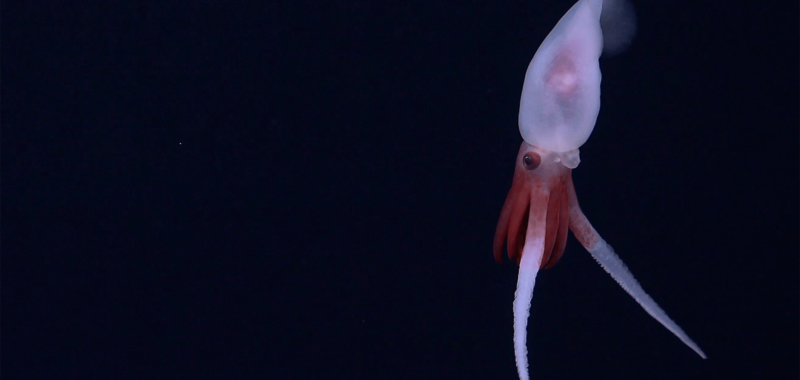Normally the animals that live at the deepest depths of the ocean can be be a little tough to look at. During an expedition in the Southern Pacific Ocean, an international team of oceanographers found some cephalopods, corals, and more that were a bit more photogenic.
The team took the first live footage of a very rare squid that you can view here. The cephalopod is from the Promachoteuthis genus, and only three species have been scientifically described to date. One species–Promachoteuthis sulcus–is known for its somewhat human-like teeth. Only a few specimens of these elusive squid have been collected, most of which are from dead specimens found in nets.
[Related: Incredible footage shows new squid species tending to enormous eggs.]
The team was mapping an underwater mountain range 900 miles off the coast of Chile when they spotted the Promachoteuthis squid. They also recorded the first documented sighting of the internet famous “Casper” octopus for the first time in this part of the Southern Pacific. Numerous corals, deep-sea sponges, fish, and even two rare Bathyphasas–aka flying spaghetti monsters–were also observed during this 28-day expedition.

“Since so little is known about this region, a lot of what we found out there is new to science, and these benthic communities are surprisingly diverse and healthy,” Tomer Ketter, Co-Chief Scientist and Schmidt Ocean Institute Marine Technician, tells Popular Science. “As much as it was a surprise, it was also very exciting to come across these oceanic havens, appearing out of the darkness and filling our camera view with vivid color and abundant life.”

Schmidt Ocean Institute led the expedition aboard the RV Falkor (too), alongside The Ocean Census, the University of New Hampshire’s Center for Coastal and Ocean Mapping/Joint Hydrographic Center, the Center for Ecology and Sustainable Management of Oceanic Islands at the Universidad Católica del Norte, and marine policy organization Oceana.

The team was mapping an underwater mountain chain called the Nazca Ridge. Along with the adjoining Salas y Gómez Ridge, Nazca is one of several global locations currently under consideration for designation as a high seas marine protected area.

During this most recent expedition, the team discovered an underwater mountain that is over 1.9 miles tall. Seamounts like these are often formed by volcanic activity and can be found in every ocean basin on Earth. They typically support a thriving deep-sea ecosystem that is teaming with life. While mapping out the seamount, the team also used an underwater robot named the ROV SuBastian to take an exploratory dive on one of the mountain’s ridges.

“The discovery of a new seamount almost 2 miles tall–almost four times as tall as the Burj Khalifa–with a vibrant ecosystem was very exciting,” Co-Chief Scientist and Schmidt Ocean Institute Executive Director Jyotika Virmani said in a statement. “Only 26% of the seafloor has been mapped to this high resolution and each expedition on Falkor (too) brings into focus a little more of the unknown seabed and life on our home planet.”
One of the mountains is home to a virtually untouched sponge garden and various deep-sea corals. The organisms provide shelter and habitat for rockfish, brittle stars, king crabs and more and is roughly the size of three tennis courts (8,611 square feet).

This is the third expedition this year conducted on the Schmidt Ocean Institute’s R/V Falkor (too). Earlier expeditions in January and February documented over 150 previously unknown species and several range extensions for animals not previously known to live on the ridge. An additional 20 suspected new species were collected during this expedition.
[Related: See the strange new species discovered near Chile—with the help of a deep-diving sea robot.]
Prior to these expeditions, 1,019 species were known to live in this part of the Pacific Ocean. Now, there are 1,300 known species and counting. The Ocean Census will confirm this count in the coming months.

Ocean Institute team, will significantly enhance our understanding of the distribution of remarkable life forms on these underwater mountains, including several that have never before been mapped or seen by human eyes,” Alex David Rogers, Science Director of Ocean Census, said in a statement.”

Understanding more about how and where these underwater flora and fauna are thriving can inform better policies around potentially destructive deep-sea mining and drilling operations.

